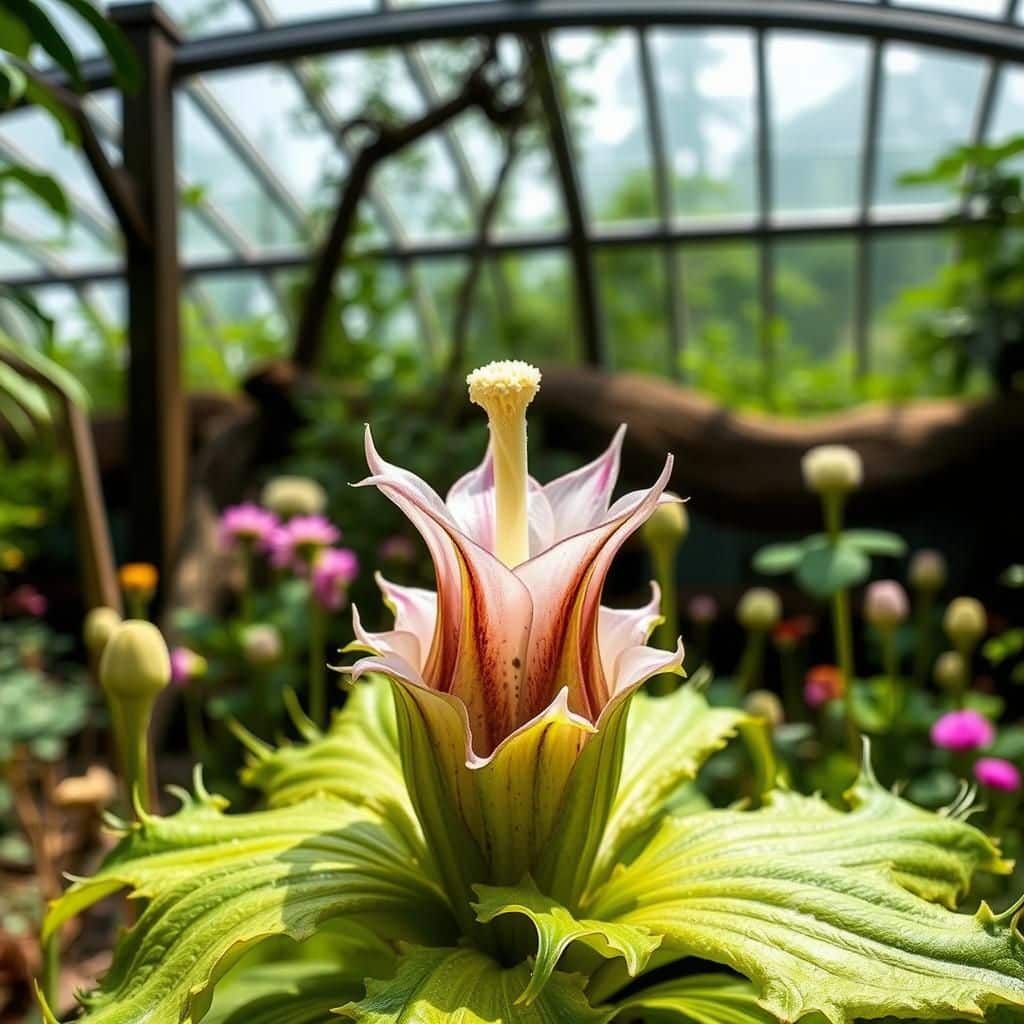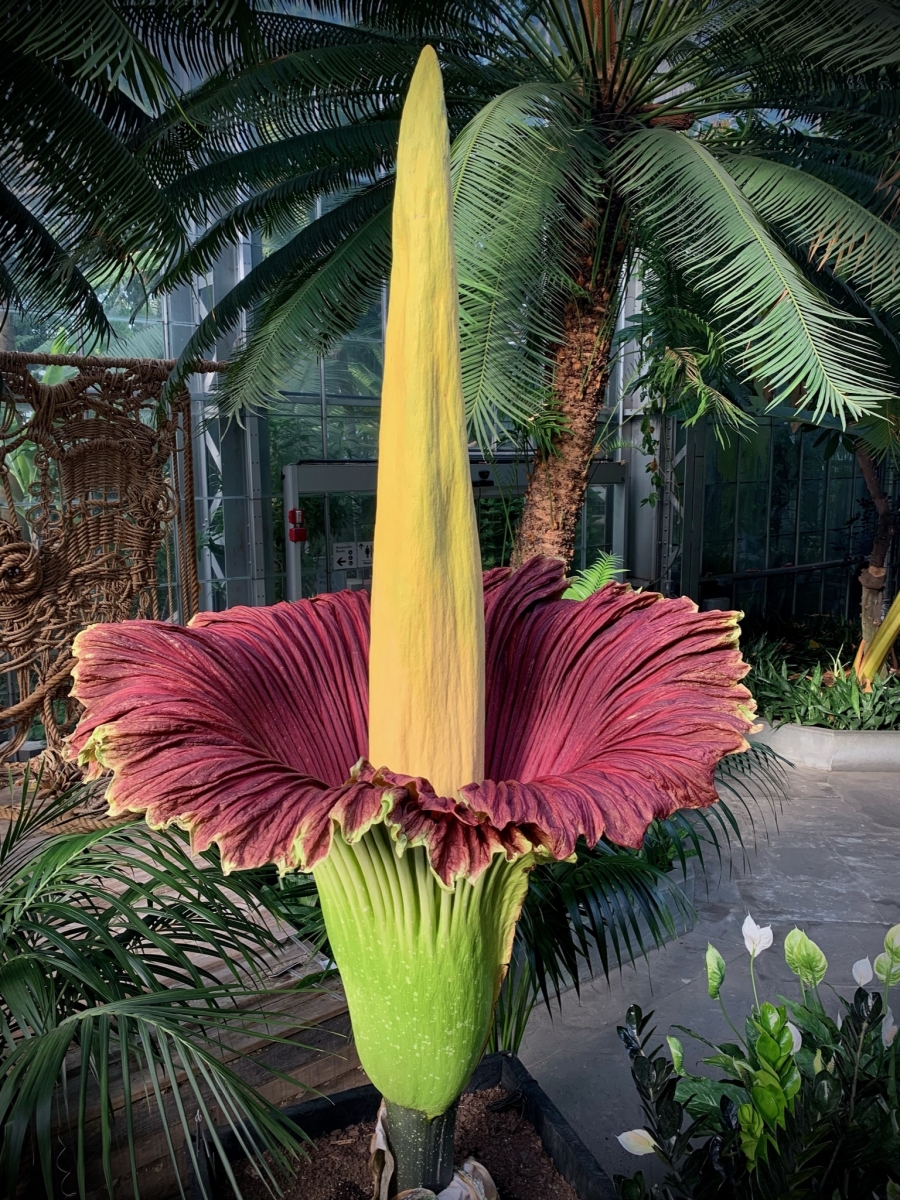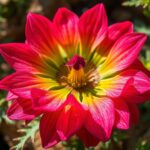Explore the Fascinating World of Corpse Plant Botanical Gardens: A Unique Floral Experience

In the realm of botanical gardens, few plants captivate the imagination quite like the corpse plant, scientifically known as Amorphophallus titanum. Renowned for its immense size, striking appearance, and distinct odor reminiscent of decaying flesh, this extraordinary bloom has become a focal point for floral enthusiasts and curious visitors alike. Exploring corpse plant botanical gardens offers a unique opportunity to witness these remarkable specimens in their natural habitat, while also delving into the science and stories surrounding them. This article invites you to journey into the fascinating world of corpse plants, highlighting their ecological significance, cultivation challenges, and the allure that draws countless individuals to experience their bloom.
The Fascinating World of Corpse Plants in Botanical Gardens
The corpse plant, known scientifically as Rafflesia arnoldii, is celebrated for its extraordinary size and unique characteristics, making it a notable attraction in various botanical gardens around the world. This rare plant is famous for emitting a strong odor reminiscent of decomposing flesh, which serves to attract its primary pollinators—carrion flies. Visitors to gardens that feature the corpse plant are often intrigued by its massive, parasitic flowers that can grow up to three feet in diameter. Understanding the ecological role and the fascinating biology of the corpse plant enhances appreciation for these unique natural wonders, making a visit to these gardens truly memorable.
Characteristics of the Corpse Plant
The corpse plant is renowned for its distinctive features, which include a large, fleshy flower that can weigh up to 15 pounds. Its petals, often a deep red or maroon, are adorned with white splotches that mimic the appearance of meat, further aiding in attracting its pollinators. One of the most intriguing aspects of this plant is its lack of visible leaves or stems, as it grows primarily as a parasite on the roots of certain host plants. This adaptation allows the corpse plant to effectively derive nutrients, showcasing nature's ingenuity.
Habitat and Distribution
Originally native to the rainforests of Southeast Asia, the corpse plant thrives in warm, humid environments where it can find suitable hosts. Its primary locations include Indonesia, Malaysia, and Sumatra, where the specific conditions are favorable for its growth. Due to habitat loss and deforestation, its populations are under threat, prompting conservation efforts to protect and preserve this remarkable species. Botanical gardens play a crucial role in cultivating corpse plants, providing a controlled environment for research and public education.
Pollination Process
The unique smell of the corpse plant, akin to rotten flesh, is a clever evolutionary strategy to attract carrion flies for pollination. Once the flies are lured to the plant, they inadvertently collect pollen as they search for food, thereby facilitating the reproductive process of the plant. This reliance on insects that are usually drawn to decay exemplifies the complex relationships within ecosystems. Botanical gardens often focus on creating awareness of this intriguing pollination process, showcasing the delicate balance of nature.
Conservation Efforts
Given that the corpse plant is classified as vulnerable by various conservation organizations, many botanical gardens are engaged in conservation efforts to protect its habitats. This includes initiatives such as propagation programs, habitat restoration, and raising public awareness about the importance of preserving this unique species. By educating visitors on the plant's ecological significance and its plight, these gardens help foster a greater appreciation and commitment to conservation, ensuring the survival of the corpse plant for future generations.
Visiting Botanical Gardens with Corpse Plants
Visiting a botanical garden that features the corpse plant can be a remarkable experience for nature enthusiasts and curious visitors alike. These gardens often provide informative signage and guided tours to explain the characteristics, uses, and ecological significance of the corpse plant. Additionally, many gardens host special events when the corpse plant is in bloom, offering a rare opportunity to witness this extraordinary phenomenon. It is advisable to check the garden's schedule in advance, as blooms are unpredictable and can occur infrequently.
| Aspect | Details |
|---|---|
| Scientific Name | Rafflesia arnoldii |
| Habitat | Rainforests of Southeast Asia |
| Flower Size | Can reach up to 3 feet in diameter |
| Pollinators | Carrion flies |
| Conservation Status | Vulnerable |
Which botanical gardens have corpse flowers?

The corpse flower, scientifically known as Amorphophallus titanum, is famous for its large size and foul odor, reminiscent of decaying flesh. Various botanical gardens around the world cultivate this unique plant for public viewing and research purposes. Here are some notable botanical gardens that have corpse flowers:
1. Brooklyn Botanic Garden
The Brooklyn Botanic Garden, located in New York City, is home to a corpse flower that has gained immense popularity among visitors. The garden features a specific greenhouse dedicated to tropical plants, where the corpse flower can bloom occasionally.
- The garden conducts educational programs about the corpse flower’s unique blooming cycle.
- Visitors are often invited to witness the rare bloom, which lasts only a few days.
- The beauty and smell of the corpse flower attract plant enthusiasts from all over.
2. Royal Botanic Gardens, Kew
The Royal Botanic Gardens at Kew, located in London, England, has a significant collection of living plants, including the corpse flower. This botanical garden is known for its extensive research and conservation efforts.
- Kew Gardens often provides detailed information on the ecological importance of the corpse flower.
- They host special events during blooming periods to engage the public.
- The garden plays a critical role in the preservation of rare and endangered plant species.
3. Missouri Botanical Garden
In the United States, the Missouri Botanical Garden is famous for having one of the most notable corpse flowers. It is a key location for tropical plant research and conservation.
- The garden offers interactive programs that educate visitors about the corpse flower's lifecycle.
- It maintains a dedicated area where the plant’s signature odor can be experienced.
- Research conducted here contributes to global knowledge on this peculiar species.
4. Jardim Botânico do Rio de Janeiro
The Jardim Botânico do Rio de Janeiro in Brazil boasts a diverse collection of tropical flora, including the infamous corpse flower. The botanic garden plays an essential role in environmental education and conservation.
See also:
- The garden provides tours that highlight the unique characteristics of the corpse flower.
- Special events are organized when the plant is in bloom, attracting large crowds.
- They engage in research projects aimed at understanding plant adaptations in tropical environments.
5. San Diego Botanic Garden
Another prominent location is the San Diego Botanic Garden in California, which has successfully cultivated several corpse flowers. This garden emphasizes sustainability and education about native and exotic plants.
- The garden features educational exhibits focusing on the biology of the corpse flower.
- Blooming events are often highlighted in the garden’s calendar, ensuring visitors do not miss the spectacle.
- They collaborate with local universities for research purposes on plant conservation.
What is special about the corpse plant?

The corpse plant, known scientifically as Rafflesia arnoldii, is remarkable for several reasons that make it stand out in the plant kingdom. This unique plant is primarily found in the rainforests of Indonesia and is widely recognized for its significant size and unusual characteristics. Here are some of the special features of the corpse plant.
Unique Size and Appearance
The corpse plant is famous for producing the largest single flower in the world, which can measure up to three feet in diameter. Its appearance is striking and somewhat unsettling due to its reddish-brown color and five large petal-like lobes, which are often covered in white spots. This flower lacks typical leaves, stems, or roots, making it quite an anomaly among flowering plants.
- Largest Flower: The size of the corpse flower can be quite surprising, with some individuals measuring more than 3 feet across.
- Petal Structure: Its petal-like lobes create a distinctive and eye-catching look that attracts attention.
- No Traditional Structure: The plant has no traditional leafy structure, which is unusual for flowering plants.
Repulsive Odor
One of the most intriguing aspects of the corpse plant is its pungent odor, which resembles that of decaying flesh. This foul smell serves an essential purpose: it attracts pollinators such as carrion flies and beetles that are drawn to carcasses. The odor is particularly strong during a short blooming period, which lasts for only a few days.
- Attracts Pollinators: The smell is specifically designed to attract pollinators that are typically interested in dead animals.
- Short Blooming Period: The flowering phase is brief, usually lasting only 2-3 days, during which the smell is most potent.
- Evolutionary Adaptation: This strategy is a unique evolutionary adaptation that aids in reproduction.
Parasitic Nature
The corpse plant is a parasitic plant, relying on a host to obtain nutrients and water. It doesn't photosynthesize, as it has no chlorophyll. Instead, the plant attaches itself to the roots of nearby host plants, such as vines in the Tetrastigma genus, extracting nutrients essential for its survival.
- Absence of Photosynthesis: Unlike most plants, Rafflesia arnoldii does not perform photosynthesis but survives through parasitism.
- Host Dependency: The plant relies on specific host plants, making it vulnerable to environmental changes.
- Root System: It forms a network with the host's roots to absorb necessary nutrients to grow and bloom.
Cultural Significance
In Indonesia, the corpse plant holds significant cultural importance. It is not only a remarkable botanical specimen but also symbolizes the unique biodiversity of the region. Local communities often showcase this plant as a part of their natural heritage, attracting tourists and researchers interested in rare flora.
- Tourist Attraction: The corpse plant draws many visitors to its native habitat, increasing awareness of biodiversity.
- Cultural Symbol: It represents the rich natural heritage of Indonesia and the importance of conservation.
- Research Interest: The plant is studied for its unique reproductive strategies and ecological roles.
Conservation Status
The corpse plant's habitat is threatened by deforestation and habitat loss, raising concerns about its conservation status. Due to its limited range and dependency on specific environmental conditions, the corpse plant faces challenges in survival, prompting conservation efforts aimed at protecting its natural rainforest habitats.
- Threatened Habitats: Deforestation poses a significant risk to the survival of this unique species.
- Conservation Efforts: Various organizations are working to protect the rainforests that harbor Rafflesia arnoldii and other endemic species.
- Public Awareness: Increasing awareness about this plant can help foster conservation initiatives to protect its ecosystem.
What is the corpse flower in National Botanic Gardens?

The corpse flower (Amorphophallus titanum) is a unique plant housed in various botanical gardens, including the National Botanic Gardens. This plant is famous for its large size, distinct smell, and remarkable bloom cycle. The corpse flower can reach heights of up to 10 feet and can weigh over 200 pounds. Its most notable characteristic is its pungent odor, reminiscent of decaying flesh, which attracts pollinators such as carrion beetles and flies. This scent is emitted primarily during its short blooming period, which lasts only a couple of days every few years. The plant's appearance is also striking, featuring a massive, wrinkled spathe that unfurls to reveal a tall, central spadix covered in small flowers.
What Makes the Corpse Flower Unique?
The corpse flower is unique for several reasons:
- Size and Appearance: The plant can grow to impressive heights and has an unusual morphology that captures the interest of botany enthusiasts.
- Odor: The smell emitted during blooming is specifically designed to mimic rotting flesh, which is an evolutionary trait to attract specific pollinators.
- Rarity of Blooming: Blooms occur infrequently, sometimes every few years, making each event highly anticipated in botanical communities.
Habitat of the Corpse Flower
The natural habitat of the corpse flower is primarily in the rainforests of Sumatra, Indonesia. Its specific growing conditions include:
- Tropical Climate: Preferring warm and humid environments, the corpse flower thrives in areas with high rainfall.
- Forest Floor: This plant usually grows in shady locations under the canopy of larger trees, where it can receive filtered sunlight.
- Soil Conditions: Rich, moist, and well-drained soil is crucial for the growth of the corpse flower.
Pollination of the Corpse Flower
Pollination is a critical process for the corpse flower, which relies on a unique strategy:
See also:
- Attraction of Pollinators: The foul odor attracts flies and beetles that thrive in decaying matter, ensuring the transfer of pollen.
- Timing of Bloom: The flower releases its scent primarily at night, coinciding with the peak activity of its pollinators.
- Flower Structure: The shape of the flower aids in trapping pollinators temporarily, increasing the chance of successful pollination.
Cultivation in Botanical Gardens
Botanical gardens play a significant role in the cultivation of the corpse flower for several reasons:
- Conservation Efforts: These gardens help conserve the species by cultivating them outside their natural habitat.
- Public Education: They provide an opportunity for education and raised awareness about biodiversity and plant conservation.
- Research Opportunities: Botanical gardens can serve as research sites for studying the unique characteristics of the corpse flower.
Visiting the Corpse Flower at the National Botanic Gardens
When visiting the corpse flower at the National Botanic Gardens, enthusiasts should take note of:
- Bloom Alerts: The gardens typically provide updates on when the corpse flower is expected to bloom, allowing visitors to plan their visits.
- Visitor Experience: Educational programs and exhibits related to the corpse flower enhance the overall experience for guests.
- Photography Opportunities: The rare sight of the blooming corpse flower offers unique photography chances, attracting both amateur and professional photographers.
Why does the corpse plant smell so bad?

The corpse plant, known scientifically as Rafflesia arnoldii, emits a notoriously foul odor that resembles that of decaying flesh. This unpleasant scent serves a critical purpose in the plant's life cycle, primarily related to reproduction. The following sections discuss the underlying reasons for this remarkable phenomenon.
Why Does the Corpse Plant Emit Odors?
The primary reason the corpse plant emits strong odors is to attract pollinators, particularly flies and beetles that are drawn to the scent of decomposition. These insects mistake the plant for a food source or a breeding site, thereby facilitating pollination. The process can be described as follows:
- Attraction of Pollinators: The smell mimics the scent of rotting meat.
- Reproductive Strategy: It ensures that the plant can reproduce by successfully attracting pollinators.
- Survival Mechanism: The plant adapts to its environment by using smells to its advantage.
The Role of Volatile Compounds
The foul odor produced by the corpse plant is due to the release of various volatile compounds that contribute to its distinctive smell of decay. These compounds include aromatic chemicals that are characteristic of decomposing organic matter. The main features include:
- Types of Compounds: The presence of compounds such as cadaverine and putrescine.
- Chemical Attraction: Insects possess receptors that detect these compounds, leading them towards the plant.
- Specificity: Different insect species are attracted by different components of the smell.
Environmental Factors Influencing the Smell
Various environmental factors play a role in how strongly the corpse plant emits its odor. Factors such as temperature, humidity, and soil composition can influence the intensity of the smell. These influences include:
- Temperature: Higher temperatures can intensify the emissions of volatile compounds.
- Humidity: Increased humidity can assist in the dispersal of the odor.
- Soil Nutrients: Nutrient availability can impact the plant's ability to produce sufficient compounds.
Comparison with Other Plants
The corpse plant's unpleasant odor is not unique; several other plants use similar tactics for pollination. However, Rafflesia arnoldii is notable for the intensity and nature of its smell. Points of comparison include:
- Corpse Flower (Amorphophallus titanum): Also emits a strong odor but has different characteristics.
- Other Flowers: Some flowers use sweet scents to attract pollinators, contrasting with the corpse plant's approach.
- Adaptation: It showcases different evolutionary strategies in plant reproduction.
The Impact on Ecosystem Dynamics
The smell of the corpse plant significantly affects the ecosystem dynamics within its habitat. This impact can be analyzed in terms of:
- Pollination Networks: The plant plays a vital role in creating intricate relationships among species.
- Biological Interactions: It influences interactions between plants and pollinators.
- Decomposition Role: The plant's odor contributes to nutrient cycling due to the attraction of decomposer organisms.
Questions from Our Readers
What is the corpse plant and where can it be found in botanical gardens?
The corpse plant, known scientifically as Amorphophallus titanum, is famous for its distinctive odor, which resembles that of rotting flesh. It can typically be found in botanical gardens with specialized collections, especially those focused on tropical plants. These gardens create specific environments to support its growth and display its unique flowering cycle.
Why does the corpse plant emit a foul odor?
The foul odor emitted by the corpse plant serves to attract pollinators, primarily carrion beetles and flesh-flies. The smell mimics that of decaying organic matter, which helps in reproduction by ensuring that these insects visit the flower for pollination during its short blooming period.
How often does the corpse plant bloom?
The corpse plant has a very irregular blooming cycle and can take anywhere from several years to decades to bloom again after a previous flowering. When it does bloom, the flowering period lasts only a couple of days, requiring enthusiasts to be on alert for this rare and dramatic event in botanical gardens.
Can you visit the corpse plant in a botanical garden?
Yes, many botanical gardens that house a corpse plant often allow visitors to see it, especially when it is in bloom. Some gardens even provide special events or educational programs to enhance the experience for those interested in learning more about this fascinating plant and its unique characteristics.
See also:

If you want to read more articles like Explore the Fascinating World of Corpse Plant Botanical Gardens: A Unique Floral Experience, we recommend you check out our Landscaping category.
Leave a Reply
Related Articles